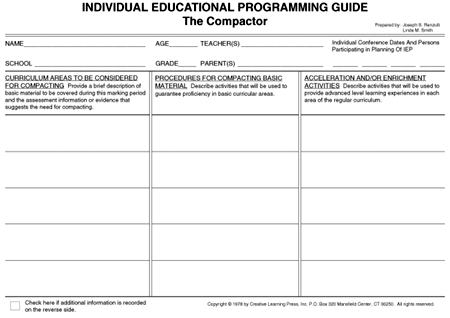As indicated, curriculum compacting is a procedure used to streamline the grade level curriculum to enable time for more interesting and challenging work. Research clearly supports the need for curriculum compacting in our elementary and middle schools.
The Bad News—Why We Need Curriculum Compacting
It is clear that a major problem facing our schools is the lack of curricular differentiation and academic challenge for many of our most able students. Research also supports this claim. In one study dealing with average and above-average readers, Taylor and Frye (1988) found that 78% to 88% of fifth and sixth grade average readers could pass pretests on basal comprehension skills before they were covered in the basal reader. The average readers were performing at approximately 92% accuracy while the better readers were performing at 93% accuracy on the comprehension skills pretests. This means many more children can benefit from compacting.
One reason that so many average and above average students demonstrate mastery of the curriculum is because contemporary textbooks have been “dumbed down,” a phrase used in 1984 by Terrel Bell, former secretary of education. Chall and Conard (1991) concur with Bell’s assessment, documenting a trend of decreasing difficulty in the most widely used textbooks over a thirty-year period from 1945-1975. “On the whole, the later the copyright dates of the textbooks for the same grade, the easier they were, as measured by indices of readability level, maturity level, difficulty of questions and extent of illustration” (p. 2).
Findings by Usiskin (1987) and Flanders (1987) indicate that not only have textbooks decreased in difficulty, but also that they incorporate a large percentage of repetition to facilitate learning. Usiskin argues that even average eighth grade students should study algebra since only 25% of the pages in typical seventh and eighth grade mathematics texts contain new content. Flanders corroborated this finding by investigating the mathematics textbook series of three popular publishers. Students in grades 2-5 who used these math textbooks encountered approximately 40 to 65% new content over the course of the school year which equates to new material two to three days a week. By eighth grade, the amount of new content had dropped to 30% which translates to encountering new material once every one and one half days a week. Flanders (1987) suggests that these estimates are conservative because days for review and testing were not included in his analysis, and concludes, “There should be little wonder why good students get bored: they do the same thing year after year” (p. 22).
The Good News—Why Compacting and Type III Enrichment Work
- In our research on compacting, we have learned that most elementary teachers can eliminate 40-50% of the basal regular curriculum for targeted students in the general student population. Additionally, in both language arts and math, many bright youngsters are able to bypass as much as 70% of the regular curriculum. For more information on this research study conducted at The National Research on the Gifted and Talented, click here.
- In a recent study, researchers modified curriculum for students and used self-selected Type III enrichment projects as a systematic intervention for underachieving gifted students. This approach (Renzulli, 1977) specifically targets student strengths and interests in order to help reverse academic underachievement (Baum, Renzulli, & Hébert, 1995).
Summary on Curriculum Compacting
The many changes that are taking place in our schools require all educators to examine a broad range of techniques for providing equitably for all students. Curriculum compacting is one such process. It is not tied to a specific content area or grade level, nor is it aligned with a particular approach to school or curricular reform. Rather, the process is adaptable to any school configuration or curricular framework, and it is flexible enough to be used within the context of rapidly changing approaches to general education. The research studies described above, and practical experience gained through several years of field testing and refining the compacting process have demonstrated that many positive benefits can result from this process for both students and teachers, and particularly, talented students who are underachieving in school.
BRIEF CHECK TO INSURE THAT YOU UNDERSTAND THE COMPACTING PROCESS
Activity
Complete the following compactor form for students whom you have selected for this process and consider the following questions:
- What areas have you identified for curriculum compacting?
- In what ways can you identify objectives?
- How can you make modification?
- What replacement activities are you considering?
Next, you can compare your form with the examples to follow.
Next Section: How to Use the Compacting Process
Previous Section: Using the Compactor to Facilitate curriculum Compacting
